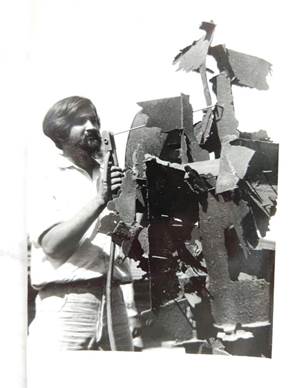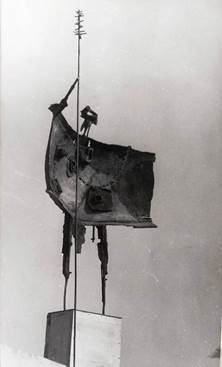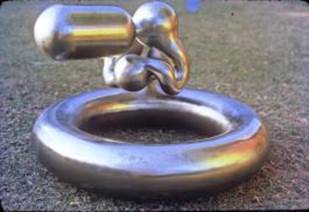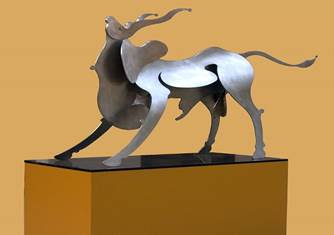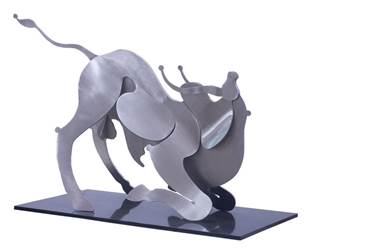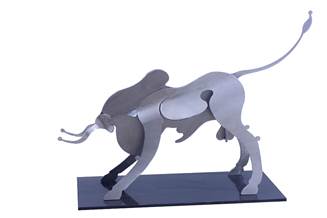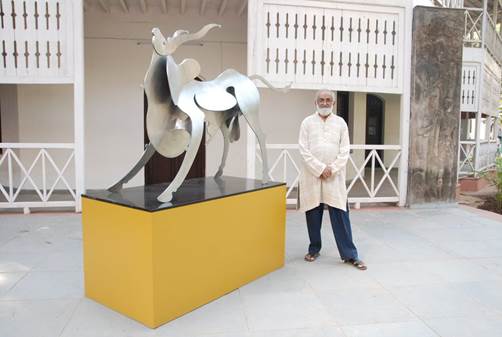ShodhKosh: Journal of Visual and Performing ArtsISSN (Online): 2582-7472
|
|
|
SCULPTED STEEL
OF RAGHAV KANERIA Dr. Giriraj Sharma 1 1 Associate Professor, Visual Art Department, IIS-Deemed to be University, Jaipur, India2 Assistant Professor, Department of Sculpture, Faculty of Fine Arts, The M.S. University of Baroda, India |
|
||
|
|
|||
|
Received 01 January 2022 Accepted 15 February 2022 Published 30 March 2022 Corresponding Author Dr. Giriraj
Sharma, giriraj.sharma@iisuniversity.ac.in DOI 10.29121/shodhkosh.v3.i1.2022.75 Funding: This research received
no specific grant from any funding agency in the public, commercial, or not-for-profit
sectors. Copyright: © 2022 The Author(s).
This is an open access article distributed under the terms of the Creative
Commons Attribution License, which permits unrestricted use, distribution,
and reproduction in any medium, provided the original author and source are
credited.
|
ABSTRACT |
|
|
|
This article is a critical
appreciation of Raghav Kaneria’s welded sculptures done in scrap metal, mild steel,
and stainless steel since 1962 to 2016.Though he has worked on many mediums
like terracotta, bronze, wood, scrap metal, cement, assemblage etc. but in
this article, I would like to concentrate only one medium and that is ‘sheet
metal’ in its different forms like mild steel, stainless steel, and scrap
metal. I have divided these works into three different phases depending on
the style and treatment of his works and subject matter. His first phase works were
mostly done with scrap metals where found objects were welded together to
create new forms. Many of these works were done when he was studying in
Faculty of Fine Arts (Vadodara) and later in a Mumbai factory. These works
have a rugged quality of the scrap metal sculptures with its strange
primitive vitality. His second phase
works were the smooth polished surfaces of abstract forms which he calls
‘sprouting’, done during his studies in Royal college of Art, London and
during his teaching period in Waltham Forest Technical College, London and
Hull College of Art, London. These
sculptures consist of smooth tubular forms created in mild steel which were
not an assemblage of direct forms, but a meticulous execution of forms
inspired by nature. His third phase is the sensuous, simplistic, and
decorative forms of Bull which he calls ‘Nandi’. They were done in stainless
steel sheets in Baroda, between 2014- 2016. These forms in stainless steel
were created using huge flat steel sheets joined together by welding. They
are simply called the Nandi forms. These three phases have different approach
of execution. In this article I have tried to bring together a selection of
his oeuvres made in ‘metal sheets’ but with very different approach in each
series evoking diverse expressions. |
|
||
|
Keywords: Raghav Kaneria,
Folk Art, Steel, Direct Metal, Scrap Metal Sculptures, Baroda School 1. INTRODUCTION
In the year 2015, Vadodara had
organized a huge festival of Art in the Faculty of Fine Arts called ‘The
VADFEST’. It was a contemporary Art Festival with National and International
Artist and had garnered a lot of attention. There, outside the old building
premise of Pushpabaug (old building of Fine Arts),
stood in attention a Majestic Bull. It was a huge beast made up of stainless
steel by Raghav Kaneria. It mesmerized the viewers with its force and sheer
presence. The lyrical beauty and the sensuous quality of the Bull drew a lot
of attention at that time, and it compelled me to write this article. Raghav Kaneria was born in Anida, Rajkot district in Gujarat, in a small and remote
village on 19th March 1936. Educated under eclectic artist Prof. Sankho Choudhury, he is an artist whose perspective on art and life carry resonance |
|
||
of village life of India. Virani (2012) His journey began in the
Post Independent milieu and in
the eclectic environment of
Baroda with its pedagogical openness and its spirit of experimentation proved
to be electrifying for this gifted artist.
He was
very much interested in steel as a medium. He says “My ideas were not suitable
for stone or wood. As a student I didn’t know welding, so I used scrap metal
pieces and attached them on wood blocks(assemblages). To do that, I joined the
ends of the metal pieces with iron nails and inserted these nails in the wood
blocks” (Kaneria). The work Cock or Rooster,
done in scrap from 1962-63 is
an example of this technique. The cock represents his simple village
life of his earlier days. Cock
is considered as a vehicle of Bahucharaji Mata
but Kaneria’s first encounter with cock came in existence when gypsies came
into his village. His construction of
the form shows the vitality and sensitivity of the material. The relation of
wood and metal itself holds an erotic appeal and at the same time addition of
nails symbolise pain also. Again, the trial-and-error method can be seen as
spontaneous and playful manner. His construction of the form shows the vitality
and sensitivity of the material. The imagery is replete with all the
markers of a modernist search for Indian symbolism yet the approach of creating
it is totally experimental.
This work created a strong urge to explore metal as a medium of expression. Gangopadhay
(1985)
2. PHASE-I
After
his Diploma from M.S. University of Baroda, Kaneria was invited by Virendra
Shah of Mukund Iron Industry. He had a factory in Mumbai which did huge
industrial castings. For metal casting, Virendra Bhai used to buy metals in the
form of scraps which he melted for his castings. He had let Kaneria use these
scraps free of cost to create his sculptures. Kaneria used these local scraps,
learnt electric welding in this foundry and created a series of works which was
exhibited in Mumbai in the year in 1963.
He had
participated in a one man show from 21st to 28th February
1963, at Jehangir Art Gallery, Mumbai, where he exhibited 14 works done in
scrap during his stay in Mumbai. The catalogue was accompanied by a write up by
Vinayak Purohit, an Art critic where he describes the tactile qualities of
Kaneria’s works. The quality of these
works that are immediately perceived are those of energy, rawness, and
boldness. Energy is obvious from the violence with which the rusted pieces are
joined with harsh protruding iron rods Purohit (1963). The material (mild steel) and the
technique (direct metal welding) are totally industrial, yet the outcome is
very organic Purohit (1963). He gives credit to three special
people for his Bombay journey- Mr. Virendra Shah, Kamalnayan
Bajaj and Dr. Vinayak Purohit.
|
|
|
Figure 1 Cactus, 1963, Medium: Scrap Metal (Kaneria, One Man Show- Catalogue, 1963) |
3. CACTUS
Discarded
agricultural tools or implements which look like fork, broken pieces of exhaust
pipes, crude bits of metal, iron rods and nails assume interesting and powerful
shapes in his hands. It is hard work to fit the odd bits and pieces into right
shapes. He continues this laborious process in his studio, until he is
completely satisfied that the welding instrument and his hand has achieved
their rugged and beautiful objective. These works have a savage beauty, a
strange violence and energy in the forms which are crude, jagged, odds bits of
metal, assumed under the direction of Kaneria’s skilful hands and the welding
instruments. The forms lack the colour that would normally please the average
eye, but they are not without a strong sense of motion. The works are elemental
and much of them strikingly beautiful in a brutal kind of way. By this time, he
had already won ten major awards in India including the two Lalit kala Academy
award in 1959 and 1963
Dhamija (1990), his works being exhibited at Paris
Biennale in 1959 and Commonwealth Art Exhibition in 1962.
Ratan Parimoo in one of his writings in “Indian Sculpture Today
1983” says -these “found” forms intermingle with his subconscious producing
every time a new shape and new form and even more strange juxtaposition. The
use of surreal pun and metamorphosis can be seen in a work where the spiky
forklike ends of partly flattened machine parts are at once a hand and trishul, though the artist calls it “Cactus”. Rawness has
given him a possibility to preserve the identity of the material which he has
used, for example, he made a cactus (1963) in welded scrap metal. He assembled
the objects without disturbing much of his surface and the industrial objects
became the sign of the modernist age.
[By 1963, he had won 13 Awards and participated in two
international shows like Biennale de Paris in Frace (1959)
and Commonwealth Art Exhibition, London (1960). His Awards include National
Award by lalit kala, New Delhi(1959 and 1963), Tamra Patra of Mumbai, State Art Exhibition,(1959 and
1960), Silver Medal of All India Sculptor’s association ,Mumbai(1960),
Governor’s Prize, Mumbai or Bombay Art Society(1960), President of India’s
Silver Plaque in All India Fine Arts and Craft Society, New Delhi(1960), Recipient
of National Cultural Scholarship awarded by Government of India from 1960-62,
Bombay Art Society, Silver medal(1961) and Gold Medal (1962), 1st
prize in Gujarat State Art Exhibition(1961) and Bombay Art Society-The Mouj Printing Bureau’s Prize in Bombay Art Society(1962).] Kaneria
(2015)
4. WARRIOR
The
presence of human figure in his work is rare, and the kind of figuration he did
in standing position look like avant garde and it is called Worrier in steel. This sculpture has
a monumental quality, and there is a journey of idea of construction in
sculpture. Here the idea and the material used are supplementary for each
other. This is now in the collection of Air India, Mumbai branch. While playing
with the junks, he came across a metal piece which had a blasted effect and the
surface cracked. That became the wound of the warrior. The question that
arises-how the idea of this sculpture came to his mind. Kaneria says that he starts
his scrap works with no sketches or pre-conceived notion. He just plays with
the different form for hours and a form emerges from it. “It is a subconscious
effort. I try to create a form from putting together loose shapes” Kaneria
(2015) Kaneria’s sculptures with their bends and
curves and assemblage depict a kind of relationship with open space.
Man-O-War-
Another example is that of Tower like web form which also appears like cave.
Their rusty decomposed surfaces, give them a primordial character, as if, they
have been there for millions of years-since the creation of universe. In
Kaneria’s sculptures one can feel the presence of rich imagination and creative
powers in the artist, which may be due to his rural origin.
Because of these factors, his works are unique
and makes him an important Indian sculptor. To my knowledge, nobody in the
country has yet explored welding of junk to such an extent and produced such startling
results. Chatterji (1983)
|
|
|
Figure 2 Chadia, Scrap Metal, 1963 Source 1st One man
Show, Jahangir Art Gallery Catalogue, Artist’s personal collection and From
Jyoti Bhatt |
|
|
|
Figure 3 Man-O-War,
Scrap metal, 1963 Source 1st One man
Show, Jahangir Art Gallery Catalogue, Artist’s personal collection and From
Jyoti Bhatt |
|
|
|
|
Figure 4 Untitled,
Scrap metal Bhatt (2021, March 5) Source 1st One man Show, Jahangir Art Gallery Catalogue, Artist’s personal collection and From Jyoti Bhatt |
|
Mr. Vinayak Purohit says in this catalogue that Kaneria’s works express vital energy and boldness of forms. The appeal is more to the eye, to the surface, to the limited but distinct range of rust colours; to the decayed and pitted surface; to an organisation of form of slightly menacing web. In this respect, the mode is contemporary Purohit (1963).
|
|
|
Figure 5 Kaneria welding his work Source: Original photo from the Artist |
|
|
|
Figure 6 Warrior, scrap metal, 8 feet
height Source: Original photo from the Artist |
5. PHASE-II
This
was followed by his Commonwealth Scholarship Awarded by British Government to
study at Royal College of Art, London, England from 1964 to 1967. Here he had
begun to build up abstract forms with only a marginal reference to
representation. They were also made in mild steel and inspired by germination.
In interaction with British sculptors like Bryan Kneale and Philip Kings, his
works furnished under logical formalist prescription, which had a place in
contemporary British sculpture. He was also guided by Professor Bernard Meadows
who was also his mentor. Meadows (1980) His works from this series was highly
appreciated in London, so much so that, he had a large works bought by the Arts
Council and the Fitzwilliam Museum in Cambridge, an unusual success for a
student. He used an abstraction conductive to the order of architectural
spaces, of large interior or exterior situations. They were large tube-like
steel forms which were smooth polished, surface and often painted.
These
sprouting works are smoothly finished metal compositions which combine organic
and technical looking machine derived forms. The pedestal or base is reduced to
a visage.
Figure 7 shows a group of works done during
this time. Most of the works were between 8 to 12 feet in height. The round
steel form that we see in these works are not ready-made forms but are created
by him with straight round pipes. The process of curving them in circular
shapes was most challenging thing technically. Each of these works has a
minimalistic approach.
His
sculpture titled ‘sprouting seed’ is one such example where he uses the
smoothness of the form to define the smoothness of the seed and the sprouts.
The material, steel is smooth yet hard and strong and this strength of the
material is used to show the power and potential of a seed to grow into a large
tree. The smoothness of the surface tempts us to touch it, feel it. The form
looks like a controlled algebra of bulging mass. He retains the solidity of
form and material lusty shine add life to the organic development in space.
|
|
|
Figure 7 Group of sculptures done in London from Artist’s personal collection |
|
|
|
Figure 8 Sprouting Seed-Mild Steel 1971 Sheikh
(1997) |
6. PHASE-III
He
comes back to steel again in 2013, but this time it is stainless Steel.
Stainless steel is much tougher than mild steel, so the possibilities are very
different than mild steel. By this time, he was already 77 years old, and
handling of such large-scale works could be possible only in a factory with the help of
technicians. Here steel sheets were used
and cut with the help of water jets, so the cuts were very precise and the
edges very smooth. They were then welded together and fixed with exact precision.
Certain pieces were bent with the help of rolling machines which means too much
dependence on technicians. Kaneria says, “…at any given day, I would prefer to
do my works on my own rather than depending on others”. Kaneria
(2015) But the works that comes out of this challenge are unique.
|
|
|
Figure 9 Nandi-1, 2014 Stainless Steel-50”x22.5”x84” Kaneria (2015) |
This is one of the sensuous, simplistic yet decorative forms of Nandi done in stainless steel sheets in Baroda between 2014 to 2016 consists of this third phase where the approach of the works are totally different than his earlier works. The Nandi series with its bold and rhythmic lines, the sensuous forms, expresses the form with a minimalist approach. These were huge beasts made up of stainless steel which mesmerizes the viewer with its force and sheer presence. It traverses time and cultures, owe as much debt to the then current international trend as to the folk art and design elements of native India.
|
|
|
Figure 10 Nandi-II, 2014, Stainless Steel-48”x36”x16” Source: Artist’s
collection |
This
particular Nandi has an upward gaze, in spirit of bold defiance and slightly
arrogant stance. Here we find amazing, robust strength of stainless steel which
the artist has taken full advantage of and use of high technology which is
apparent in its precise cuts of the edges. The volume has been created by
bending the thick metal sheets in a machine. He has used laser technology to
cut out the sensuous contours with bold precision and emotive depth.
|
|
|
Figure 11 Nandi-II, 2014, Stainless Steel-48”x36”x16”. Source: Artist’s collection |
Steel, which is an industrial material with its smooth surface, looks very cold and aloof. But in this work, the energy and vitality of the beast is felt. This Nandi has again taken an aggressive stance as if about to charge or attack but there is somewhere a touch of playfulness in it.
Normally, when the word Nandi is uttered, the image that comes to one’s mind is that of a simple squatting bull as seen in Shiva temples but Kaneria’s standing Nandi is full of sensuous power. The stainless steel reflects the light, and it seems gleaming and flawlessly smooth surface that expresses a subtle touch of softness reflecting on the Artist’s love for animals. All these beautifully sculpted forms emerge as richly sensuous and sublime works of art.
7. Objectives
The
aim of this article is to explore the creative journey of Raghav Kaneria
through one medium-
‘steel’ in it’s different forms like scrap, mild steel and stainless steel and the various expressions and
technical possibilities within that medium. I have tried to bifurcate all his
direct metal works in three categories and explore the various possibilities of
each category in terms of language, treatment, and concept. It is to explore
the creative inner self of Kaneria, who even at the age of 86, still has the
capacity to surprise us with his inherent zest, capturing the moments of his
mundane life. His works are an inspiration to Art students, numerous Art lovers
and Art practitioners, around the world.
8. CONCLUSION
Thus, we find that in all these works,
though the medium is steel, the expressions and approach of works are very
different. It suited him very well as it resonated with his own
predilections. One of the
underlying preoccupations that one witnesses time and again in his carefully
built syntax is of cross-referencing and eclectic synthesis of traditional and
modern. His talent is clear
for all to see gaining acclaim and respect, not only for his extraordinary
technical skill, but also for its beauty of form and expressive quality.
|
|
|
Figure 12 Nandi-II, 2014, Stainless Steel-56”x32”x12”
(Kaneria R.) source: Artist’s collection |
RefErences
Balamani. M. (2020). Raghav Kaneria. Journal of Creative Arts & Minds. 6, (2). Fall/Winter, 109-125.
Bhatt, Jyoti, (2021) Fabers- Gujarati Sabha, 3 monthly. Raghav Kaneria, January –, Juhu, Mumbai.
Meadows. B. (1980). Bernard Meadows at Royal College of Art 1960-1980’ The Royal College of Art, London.
Purohit, V., (1963). 1st One man show of Raghav Kaneria, Jehangir Art Gallery, Mumbai, 2.
Dhamija, R. (1990). Catalogue of” National Exhibition of Art 1955-1990” Lalit Kala Akademi, New Delhi, 39.
Gangopadhay, S. (1985). Raghav Kaneria ke murtishilpa. Samakaleen Kala, (5), 23-24.
Gadney, R. (1980). Bernard Meadows at Royal College of Art 1960-1980. Catalogue. London.
Kaneria, R. (2015). Exhibition of Raghav Kaneria, Catalogue. Vadodara, Gujarat, Red Earth Art Gallery.
Parimoo, R. and R. Chatterji, (1983). Indian Sculpture Today-1983, Raghav Kaneria, Jehangir Art Gallery, Mumbai. 63-64.
Sheikh, G. (1997). Contemporary Art in Baroda. Tulika Publication.
Virani. R.S. (2012). Pratistha Smaranika-5. Nisargni nisharma nikhrelo kalakar-Anidathi England. 65.
|
|
 This work is licensed under a: Creative Commons Attribution 4.0 International License
This work is licensed under a: Creative Commons Attribution 4.0 International License
© ShodhKosh 2022. All Rights Reserved.






